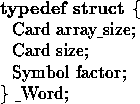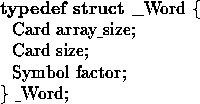When designing Unifpack it was noticed that an object oriented approach will
simplify things enormously,
instead of using a traditional OO programming language
I decided to make it in plain C partly because
I didn't feel confident in any other programming language and partly
as an exercise on how to implement OO in a traditional language
![]() ,
although many people are quite familiar with OOP and its implementation
(at least at the very simple level of Unifpack) I think that some
people will benefit from what follows.
,
although many people are quite familiar with OOP and its implementation
(at least at the very simple level of Unifpack) I think that some
people will benefit from what follows.
Unifpack is ``object based'' that is,
the basic unit of programming are objects defined by some
access functions and not by the data they contain,
the ``user''
doesn't need to know the way each object is represented,
he only
needs to know those access functions (often called the ``interface'')
furthermore,
the access functions limit the way in which an object
can be used,
thus making the keep of ``consistency'' easy.
The most natural way to represent complex data in C is using
struct's, but we have to avoid direct access to to the
fields of an structure (object), otherwise the interface can be
superseeded by the user.
This is achieved by the use of a simple but efficient data-hiding
mechanism.
As an example let us consider the Word class
![]() ,
this class will represent words in certain generators of type
Symbol that we don't need to know right now
a possible structure is
,
this class will represent words in certain generators of type
Symbol that we don't need to know right now
a possible structure is

where Card is simply an unsigned integer, array_size is the size of factor, size is the number of elements in factor that are being used. Instead of that we define
typedef struct __Word *Word;
the type is well defined because the size of a pointer is well known,
routines that only have this type cannot access the fields in
Word, because they do not even know how are called those fields,
on a separate file, for instance word.ph,
![]() we define the structure __Word as
we define the structure __Word as

in this way the access functions can know what are the fields and can manipulate them.